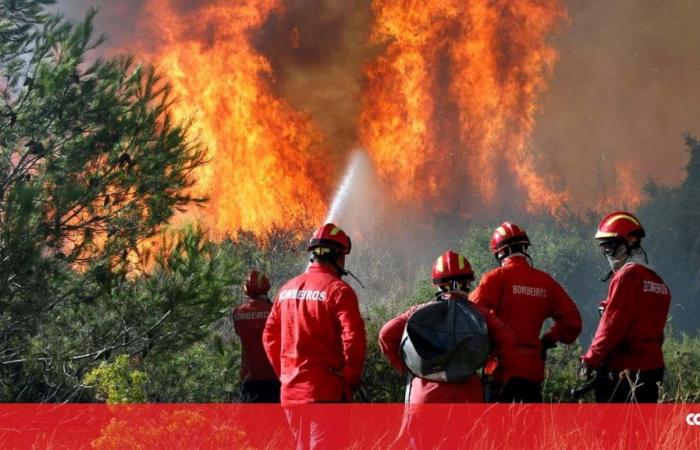
The management of fuel strips on forest land aims to prevent rural fires, but ANEFA — National Association of Forestry, Agricultural and Environmental Companies questions the annual cleaning and argues that the strategy should be rethought.
“We don’t really understand the need to repeat annually, for the standards that are being required, that is, the height of the grass and these types of situations”, stated the president of the board of directors of ANEFA, Pedro Serra Ramos, in statements to Lusa.
The forestry engineer added that annual cleanings, for the association, “have an added concern”: in many cases people focus on cleaning areas where it is mandatory, “but then leave behind the management of the forest areas themselves “.
“In other words, as the money is not enough for everything, what ends up being noticed is that there is a concern – the little money there is is used to clean up, so as not to be subject to fines -, but then forest management remains to be done, because there is no more money”, he explained, admitting that this may not be “that positive from the point of view of preventing” rural fires.
For the leader, it will be time to “seat the different actors involved in this around the table again”, to discuss “whether it is worth continuing with this strategy”, because the 50 meter strip around a building “and then the rest is a disgrace”.
According to the most recent annual report of the Integrated Rural Fire Management System, from 2022 — the 2023 document will be delivered to the Government soon –, the “global execution of 73,248 hectares was reported (14,210 hectares less compared to 2021, a decrease of 17%), not reaching the accumulated value established by the entities”.
The document reports, in terms of fuel management, 65,693 hectares (ha) in 2019, 70,387 ha in 2020 and 88,058 ha in 2021.
These numbers do not include, “due to lack of adequate reporting mechanisms, the majority of private entities (forest and agricultural owners, individual or collective) and local authorities”, which have a very relevant weight, the report states.
In relation to the Institute for Nature Conservation and Forests (ICNF), the decrease was due to a 50% decrease in the area created using controlled fire and burning (1,829 ha) and a 10% decrease in the area created in mosaics (14,523 ha), compared to the previous year.
The document also records the slight increase in the execution of the primary network (7,871 ha) and the protection of high-value areas through 18 pilot projects (1,901 ha).
The 2022 report highlights that it is “increasingly urgent to reinforce measures that encourage private involvement and the consequent investment in forestry measures, good management after forestry exploitation”, among others.
The clearing of agricultural and forestry land, to be completed by April 30, suffers, however, from a shortage of labor across the country.
“There are areas more affected than others, all companies are suffering a little with a lack of qualified personnel to carry out the work”, said Pedro Serra Ramos, highlighting that companies, as they realized that the situation “will continue”, were investing in mechanization.
The reality is also known to the National Federation of Forest Owners Associations (FNAPF).
“There are already cleaning robots. There are other more advanced systems, they have become very mechanized,” said the president, Luís Damas, recognizing that there will always be dependence on labor, for manual work or workers specialized in operating machines. .
In areas like Abrantes, district of Santarém, it is still possible to find Portuguese workers, while other companies “already have teams made up of immigrants”, in areas like Viseu or Oliveira do Hospital, where there is a lot of industry.
The leader said that “the coastal regions have some difficulty in labor”, even though in the interior some work can be complementary to local activity.
Pedro Serra Ramos stressed that, “in most cases”, immigrants are also “not prepared to carry out these jobs”.
“The tendency will be to increasingly look for mechanization solutions that, in some way, make up for this lack of labor, because it is different” to “attract young people to work, for example, with robots and deforestation, than to grab a motor brushcutter and cut the bush”, he stressed.
For Serra Ramos, prevention should be done through the management of forestry space, which has not happened, and “the proof is in the level of afforestation”, which “is practically zero”.
“Owners often do not have the income available to pay for professional forestry management and, therefore, this is where the State should invest much more than in the pure and hard cleaning of small areas, just to protect urban spaces”, he argued. .
Seven years after the tragic fires of 2017, he stressed, “the strategy for professional forest management should have already been identified”, instead of “only focusing on raising people’s awareness”, and preparing the future of forest prevention in relation to climate change and rural fires.
“It’s time to sit down at the table and do what we […] can be called a sustainability plan for the Portuguese forest”, proposed the head of ANEFA, when, more than half the deadline and with only 870,000 trees planted, it is far from the European Union’s target of planting 3,000 million trees in the European space
Tags: Association forestry companies annual cleaning strategy prevent fires rethought Society
--




